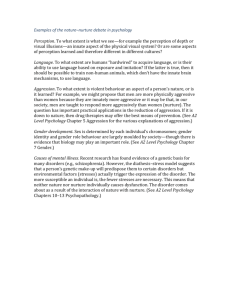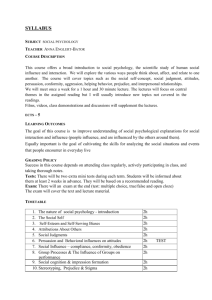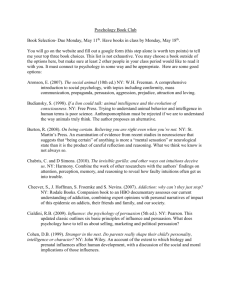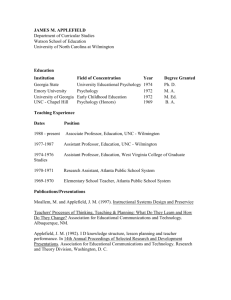Driver Aggression as a Function of Status Concurrence: An Analysis
advertisement
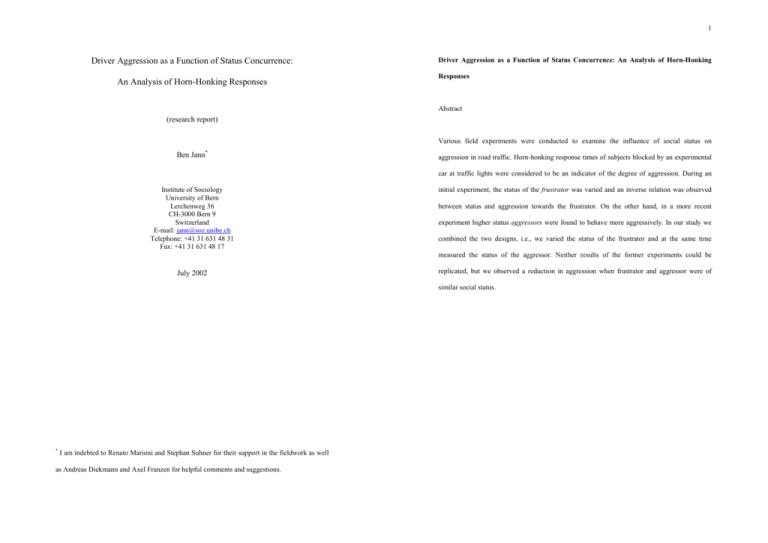
1 Driver Aggression as a Function of Status Concurrence: An Analysis of Horn-Honking Responses Driver Aggression as a Function of Status Concurrence: An Analysis of Horn-Honking Responses Abstract (research report) Various field experiments were conducted to examine the influence of social status on * Ben Jann aggression in road traffic. Horn-honking response times of subjects blocked by an experimental car at traffic lights were considered to be an indicator of the degree of aggression. During an Institute of Sociology University of Bern Lerchenweg 36 CH-3000 Bern 9 Switzerland E-mail: jann@soz.unibe.ch Telephone: +41 31 631 48 31 Fax: +41 31 631 48 17 initial experiment, the status of the frustrator was varied and an inverse relation was observed between status and aggression towards the frustrator. On the other hand, in a more recent experiment higher status aggressors were found to behave more aggressively. In our study we combined the two designs, i.e., we varied the status of the frustrator and at the same time measured the status of the aggressor. Neither results of the former experiments could be July 2002 replicated, but we observed a reduction in aggression when frustrator and aggressor were of similar social status. * I am indebted to Renato Marioni and Stephan Suhner for their support in the fieldwork as well as Andreas Diekmann and Axel Franzen for helpful comments and suggestions. 2 I. Introduction 3 To summarize, the results of the study by Doob and Gross (1968) and the study by Diekmann et al. (1996) are as follows: On the one hand, low status blocking objects elicited faster reactions Doob and Gross (1968) measured horn-honking response times as an indicator of aggression of and thus higher levels of aggression than did high status frustrators. On the other hand, high car drivers when blocked by an experimental car at traffic lights in the United States (N=74). status aggressors reacted faster to a blocking object than did low status aggressors. In our study, They used two blocking cars indicating different levels of social status. As response times were we now investigate a possible interaction effect between the status of the frustrator and the significantly shorter and responses occurred significantly more frequently when a driver was status of the aggressor. We assume that the similarity (or difference, respectively) of the status frustrated (i.e. blocked) by a lower class automobile, Doob and Gross concluded that the status of the actors determines the aggressiveness of behaviour rather than the status of one or the of frustrator and aggression towards the frustrator are inversely related. Deaux (1971) found a other per se. To speak in terms of Game Theory, we assume that the disposition to cooperate is 1 similar (non-significant) effect in a replication of the experiment. Furthermore, in a study by generally higher between subjects of similar social status and thus—if we view cooperation as McGarva and Steiner (2000) drivers responded more aggressively to provocation by a low the suppression of aggression—lower degrees of aggression should be observed in such cases. status driver than to provocation by a high status driver. In order to show “… just how minimal a degree of similarity between two people is necessary On the other hand Diekmann, Jungbauer-Gans, Krassnig, and Lorenz conducted an experiment for them to have a sense of ‘belonging together’” Miller, Downs, and Prentice (1998, p. 475) to explore “… the effect of the social status of a frustrated person on the tendency to react in an had subjects play prisoners dilemma games against fictitious subjects sharing the same birthday. aggressive manner” (1996, p. 761). Again, drivers were blocked at traffic lights (this time in They found a clear increase of the level of cooperation compared to the control group of non- Germany, N=57) and horn-honking response times were recorded. However, instead of varying birthday mates. Furthermore, research on social categorization and intergroup behaviour (Tajfel, the status of the blocking car (frustrator) the status of the blocked car (aggressor) was measured. Billig, Bundy, & Flament, 1971; Billig & Tajfel, 1973; Turner, Brown, & Tajfel, 1979; Tajfel, In the study by Diekmann et al. a positive relationship was found between the status of the 1978, 1982a, 1982b; Mummendey & Schreiber, 1983; Brewer & Kramer, 1985; Robinson, aggressor and the degree of aggression (with the exception of the lowest class aggressors who 1996, to name just a few) revealed a strong bias towards favouring the in-group in many acted fairly aggressively, too). contexts—importantly, even “… in the absence of comparison with any other groups” (Brewer, 1979, p. 321; also see Kramer & Brewer, 1986). Grzelak—in an introductory textbook on social psychology—hits the spot, writing: “… there are grounds for expecting that the number and 1 However, in an Australian replication by Bochner (1971) no relationship was measured between the strength of real-life conflicts can be substantially reduced when the participants are willing and (rather unconventionally indicated) status of the frustrator and horn-honking latencies. Chase and Mills able to find any cues, any reason to think of the other(s) as belonging to the same category, (1973) even found an effect pointing in the opposite direction. In their replication of the experiment in the sharing the same fate, and thus being true partners rather than opponents” (1988, p. 310). Thus, United States the higher status frustrator elicited significantly faster horn-honking responses than the lower status frustrator. we hypothesize that in cases of status concurrence less aggressive behaviour, i.e. slower honking reactions, are to be expected and vice versa—in particular because social status 4 5 presumably is a rather strong determinant of social cohesion (Hechter, 1987, p. 176). After carrying out a pre-test, our experiment was conducted on two consecutive Saturday Presupposed assumptions are, of course, that the car driven by a subject serves—at least to some mornings in spring 1995 at an intersection with relatively light traffic in Bern, Switzerland. On degree—as a means of expression of the subjects’ social status (Marsh & Collett, 1986, leave no the first day we used an experimental car indicating high social status and on the second, a car doubt in this regard), and that other subjects also perceive the social status expressed by means indicating low social status.2 Traffic conditions were similar on both mornings, but the weather of a car (this seems reasonable, too, since Knapper & Cropley, 1980, show that the perception was slightly nicer the first day. An experimental trial was carried out if the experimental car and interpretation of the other drivers characteristic is usually quite vivid). could be stopped in the front position at the red light and if just one car was following.3 After the light turned green, the experimental car remained stopped until the first honking response occurred from the car behind. Inside the experimental car were a driver and two observers, all II. Method male. One observer measured the time between the light changing and the honking response. Using the mirrors, the other observer took down some information about the blocked subject, In order to test our hypothesis we blocked cars at traffic lights using an experimental car and including sex and estimated age of the driver, as well as make, model, and status (classified into measured horn-honking response times in a similar manner to Doob and Gross (1968). Despite three hierarchical categories) of the vehicle. If a blocked subject did not respond within the 12- the concerns expressed by some authors about the validity of horn-honking latencies as a second period of the green light the case was taken down as censored at t = 12. All in all we measure of aggression (McGarva & Steiner, 2000; Ellison-Potter, Bell, & Deffenbacher, 2001) observed 123 valid cases, approximately 60 on each morning, of which 26 were censored. the method has proven to be quite useful to study aggressive behaviour in a naturalistic setting (also see Baron, 1976, p. 272, who provides evidence that “… it seems reasonable to view horn- Since there are censored response times, the techniques of event history modeling are the most honking as an aggressive response …”). Besides the already mentioned (Doob and Gross, 1968; appropriate statistical tools for analyzing the data (Diekmann et al., 1996, p. 763). We will use Deaux, 1971; Bochner, 1971; Chase and Mills, 1973; Diekmann et al., 1996) quite a few horn- the product-limit method to estimate median response times as descriptive measures. honking experiments have been realized in past. Forgas (1976) studied reactions to national stereotypes in Europe, Turner, Layton, and Simons (1975) studied the influence of victim visibility and aggressive stimuli, Ellison, Govern, Petri, and Figler (1995) the influence of 2 The experimental cars used were a black 1995 Audi A6 2.6L as high status car and a blue 1989 Volkswagen Golf C1 Mark III as low status car. subject anonymity, McDonald and Wooten (1988) and Baron (1976) the influence of 3 incompatible responses, and Baron (1976) as well as Kenrick and MacFarlane (1986) the Summala, 1999, did not find any relation between exposure to traffic congestion and driver aggression). influence of ambient temperature. Furthermore, Shinar (1998) used the method to study the At least, Yinon and Levian (1995) have shown that the presence of drivers behind or aside increases the influence of various situational factors on aggressive driving. frequency of traffic violations. Additionally, Baxter et al. (1990) provide evidence that the presence of The presence of other drivers may influence horn-honking behaviour (even though Lajunen, Parker, & passengers has effects on driver behaviour. Unfortunately, this has not been controlled for in our experiment. 6 7 Multivariate analysis will be conducted via the semi-parametric Cox regression model (Cox, 1).5 Secondly, no decrease in response times can be observed for higher status aggressors (last 1972; Blossfeld & Rohwer, 1995; Diekmann & Mitter, 1984).4 In the Cox model, the hazard column of table 1). rate r(t) of horn-honking—i.e. the probability of a horn-honking event at time t conditional to [Table 1 about here] the fact that the event had not yet occurred—is specified as r(t) = h(t) exp(βX) However, if looking at the first and second column of table 1, one can find some evidence for our hypothesis about an interaction between the status of the frustrator and the status of the where h(t) is an unspecified baseline hazard rate and X is a covariate vector. The parameter aggressor. In the case of the lower status frustrator, the highest status aggressors showed the vector β is the vector of the (proportional) effects of the covariates on r(t). In the following most aggressive behaviour and in the case of the higher status experimental car, the lowest analysis we will report the exponents of the estimates of β since they can be interpreted status aggressors had the fastest median response time. straightforwardly as multiplication effects on r(t), i.e. as hazard ratios. The Cox regression assumes proportional hazards at each point in time. Departure from this assumption has been Since the median estimators are not very robust for small case numbers and because controls tested and found to be negligible for the following models. should be carried out for third variables (the assignment of the status of the aggressors is nonrandom and, therefore, may depend upon variables such as sex or age), we further analyze the data by estimation of multivariate Cox regression models. Model 1 in table 2 is designed to test III. Results the status effects reported by Doob and Gross (1968) and Diekmann et al. (1996). Again, these effects are clearly not supported by our data. Our estimates even point in the opposite direction Table 1 shows the median response times by status of frustrator and aggressor. As one can see, (although not significantly): higher status frustrators elicited faster horn-honking reactions than the results of Doob and Gross (1968) and Diekmann et al. (1996) could not be replicated. First, lower status frustrators (approx. 20 % increase of the hazard rate) and middle and higher status there is no increase in median response time for higher status frustrators (bottom row of table 5 The lack of this effect might be due to different weather conditions. As mentioned, weather was somewhat nicer, i.e. warmer, on the first day when the high status condition was employed. In line with Kenrick and MacFarlane (1986) as well as Baron (1976), who have shown that temperature has a strong 4 Among a number of parametric models (exponential, Gompertz, Weibull, log-logistic, log-normal, and effect on horn-honking behaviour (for an overview see Anderson, 1989), one would expect faster horn sickle) the Weibull model was found to fit our data best (interestingly, estimation is pointing towards a honking reactions on warmer days. This could have ironed out the status effect of the frustrator. linearly increasing hazard rate over time). However, the results do not significantly defer from the results Nonetheless, our hypothesis of an interaction between the status of the frustrator and the status of the of the Cox regression and, therefore, we will not report them. aggressor should still be testable. 8 9 aggressors behaved less aggressively than lower status aggressors (21 % and 38 % decrease of the hazard rate, respectively). Furthermore, there is also a gender effect (although not clearly significant): the hazard rate for female drivers was 36% below the rate for male drivers. This is in accordance with the findings [Table 2 about here] of Doob and Gross (1968) and Shinar (1998, pp. 149-150; also see Ellison-Potter et al., 2001, who found males to behave more aggressively in a driving simulation task). However, in several To test the hypothesis of less aggressive behaviour in the case of similar status between replications of the horn-honking experiment (Deaux, 1971; Chase & Mills, 1973; Turner et al., frustrator and aggressor, we introduced two dummy-variables measuring the degree of status 1975; Forgas, 1976; Kenrick & MacFarlane, 1986; Ellison et al., 1995; Diekmann et al., 1996; difference in model 2 (small difference: middle status aggressor and lower or higher status Shinar, 1998, pp. 151-156) the effect of the sex of the aggressor—although pointing in the right frustrator, respectively; large difference: lower status frustrator and higher status aggressor or direction most of the time—has not been significant. Taken all together, we conclude that vice versa). As expected, differences in status between frustrator and aggressor increase the gender is most likely to have an effect on “mild driver aggression” such as horn-honking, but hazard rate of horn-honking by quite a margin (approximately 40 % in the case of a small status the effect is small and possibly depends on situational factors such as, e.g., the sex of the difference and 100 % in the case of a large status difference). Since the null-hypothesis of a frustrator or the presence and characteristics of passengers. According to Hennessy and linear effect of the status difference—i.e., that the log of the hazard ratio for a small difference Wiesenthal (2001) a more distinct difference between men and women may be expected in the is exactly half of the log of the ratio for a large difference—cannot be rejected (Wald test: χ2 (1) case of “driver violence”, i.e. more severe forms of behaviour such as chasing other drivers or = 0.02, p = 0.89), we might as well proceed with the more efficient model 3 (where the vandalizing vehicles. difference in status is coded as follows: 0 = no difference; 1 = small difference; 2 = large difference). Again we observe a significant status dissimilarity effect, i.e., the greater the Finally, young and—rather oddly—old drivers responded more aggressively. But, since we had difference in status between frustrator and aggressor the higher the hazards of horn-honking or, no elaborated expectations with regard to age, we do not want to stress its interpretation here. to put it the other way round, the greater the similarity in status the slower the horn-honking Thinking of the stereotype of aggressive young male drivers, one could possibly expect responses.6 interaction effects between sex and age (cf. Shinar, 1998; Hauber, 1980; Richman, 1972). However, we could not find any such relation (not shown). 6 Our model assumes a symmetric effect, i.e., that a certain absolute difference in status—regardless if positive or negative—always has the same effect. To loosen this assumption we also tested a possible interaction between the status of the frustrator and status difference, i.e. the effect of a positive versus a IV. Conclusion negative difference. Although quite substantial (the effect was stronger in the case of a negative status difference, i.e., if the status of the frustrator was higher than the status of the aggressor) the interaction term has not proven to be significant. The results of our experiment provide evidence that similarity in social status between two actors can, in effect, reduce the degree of aggression expressed in real life interaction. Latencies 10 11 of horn-honking responses were significantly higher in cases where the driver of a car was how important different sources of similarity are, and how they rule out or reinforce each other blocked by an experimental car of similar status than in cases where the statuses of the two cars has to be the topic of further research. An interesting task might be, for example, if our were clearly different. Our data, however, do not reveal whether it is actually similarity which hypothesis about the effect of similar social status not only holds in the case of anti-social reduces aggression or rather difference which increases it. responses as in our experiment, but also in the case of pro-social responses such as, e.g., helping others in a parking lot (cf. Hecht, 1991). A closer look at the results of the study of Diekmann et al. (1996) reveals that they are quite well in accordance with our findings (without being proof of our hypothesis). The experimental car used to block the intersection by Diekmann et al. was classified as “lower middle class”, the References: class of aggressors who showed the lowest level of aggression in their experiment (while the level of aggression increased monotonically for higher status classes, it was also higher in the Anderson, C. A. (1989). Temperature and aggression: ubiquitous effects of heat on occurrence of human violence. Psychological Bulletin, 106, 74-96. remaining lower class). Furthermore, our findings can even contribute to an explanation of the controversial results of the studies where only the status of the frustrator has been varied. According to our hypothesis the results of such experiments depend on the composition of the Baron, R. A. (1976). The reduction of human aggression: a field study of the influence of incompatible reactions. Journal of Applied Social Psychology, 6, 260-274. Baxter, J. S., Manstead, A. S. R., Stradling, S. G., Campbell, K. A., Reason, J. T., & Parker, D. (1990). Social facilitation and driver behaviour. British Journal of Psychology, 81, 351-360. sample of blocked subjects. If there are lots of high status subjects in the sample, e.g., because the experiment has been conducted in a rather wealthy area, one would expect a lower status frustrator to elicit more aggressive responses than a higher status frustrator, just as observed by Billig, M., & Tajfel, H. (1973). Social categorization and similarity in intergroup behaviour. European Journal of Social Psychology, 3, 9-26. Blossfeld, H.-P., & Rohwer, G. (1995). Techniques of event history modeling. New approaches to causal analysis. Mahwah: Lawrence Erlbaum. Doob and Gross (1968) and Deaux (1971). On the other hand, if there are many low status subjects, one would expect more aggressive responses in the case of a higher status frustrator, as Bochner, S. (1971). Inhibition of horn-sounding as a function of frustrator’s status and sex: an Australian replication and extension of Doob and Gross (1968). Australian Psycologist, 6, 194199. reported by Chase and Mills (1973). Unfortunately, these studies do not provide any such information on the composition of the sample. Brewer, M. B. (1979). In-group bias in the minimal intergroup situation: a cognitivemotivational analysis. Psychological Bulletin, 86, 307-324. Brewer, M. B., & Kramer, R. M. (1985). The psychology of intergroup attitudes and behavior. Annual Review of Psychology, 36, 219-243. Our findings are supported by a study by Miller et al. (1998) in which similarity between actors (in this case, being birthday mates) increased the rate of cooperation in a prisoner’s dilemma. Along with Miller et al. we assume that similarity is likely to activate some sense of “belonging Chase, L. J., & Mills, N. H. (1973). Status of frustrator as a facilitator of aggression: a brief note. The Journal of Psychology, 84, 225-226. Cox, D. R. (1972). Regression models and life-tables. Journal of the Royal Statistical Society, Series B, 34, 187-220. together” or belonging to the same category or group. Thus, also mechanisms of in-group bias which increase cooperation or decrease aggression are likely to be activated. In which social situations, under which conditions, and to what extent these processes work or do not work, Deaux, K. K. (1971). Honking at the intersection: a replication and extension. The Journal of Social Psychology, 84, 159-160. 12 13 Diekmann, A., Jungbauer-Gans, M., Krassnig, H., & Lorenz, S. (1996). Social status and aggression: a field study analyzed by survival analysis. The Journal of Social Psychology, 136, 761-768. McDonald, P. J., & Wooten, S. A. (1988). The influence of incompatible responses on the reduction of aggression: an alternative explanation. The Journal of Social Psychology, 128, 401406. Diekmann, A., & Mitter, P. (1984). Methoden zur Analyse von Zeitverläufen. Anwendungen stochastischer Prozesse bei der Untersuchung von Ereignisdaten. Stuttgart: B. G. Teubner. McGarva, A. R., & Steiner, M. (2000). Provoked driver aggression and status: a field study. Transportation Research Part F, 3, 167-179. Doob, A. N., & Gross, A. E. (1968). Status of frustrator as an inhibitor of horn-honking responses. The Journal of Social Psychology, 76, 213-218. Miller, D. T., Downs, J. S., & Prentice, D. A. (1998). Minimal conditions for the creation of a unit relationship: the social bond between birthdaymates. European Journal of Social Psychology, 28, 475-481. Ellison, P. A., Govern, J. M, Petri, H. L., & Figler, M. H. (1995). Anonymity and aggressive driving behavior: a field study. Journal of Social Behavior and Personality, 10, 265-272. Ellison-Potter, P., Bell, P., & Deffenbacher, J. (2001). The effects of trait driving anger, anonymity, and aggressive stimuli on aggressive behavior. Journal of Applied Social Psychology, 31, 431-443. Forgas, J. P. (1976). An unobtrusive study of reactions to national stereotypes in four European countries. The Journal of Social Psychology, 99, 37-42. Grzelak, J. (1988). Conflict and cooperation. In M. Hewstone, W. Stroebe, J.-P. Codol, & G. M. Stephenson (Eds.), Introduction to social psychology (pp. 288-312). Oxford: Blackwell. Mummendey, A., & Schreiber, H.-J. (1983). Better or just different? Positive social identity by discrimination against, or by differentiation from outgroups. European Journal of Social Psychology, 13, 389-397. Richman, J. (1972). The motor car and the territorial aggression thesis: some aspects of the sociology of the street. The Sociological Review, 20, 5-27. Robinson, W. P. (Ed.) (1996). Social groups and identities. Developing the legacy of Henri Tajfel. Oxford: Butterworth-Heinemann. Shinar, D. (1998). Aggressive driving: the contribution of the drivers and the situation. Transportation Research Part F, 1, 137-160. Hauber, A. R. (1980). The social psychology of driving behaviour and the traffic environment: research on aggressive behaviour in traffic. International Review of Applied Psychology, 29, 461-474. Tajfel, H. (Ed.) (1978). Differentiation between social groups. Studies in the social psychology of intergroup relations. London: Academic Press. Hecht, M. A. (1991). Effect of car status on helping behavior in the parking lot. Psychological Reports, 68, 899-907. Tajfel, H. (Ed.) (1982a). Social identity and intergroup relations. Cambridge: Cambridge University Press. Hechter, M. (1987). Principles of group solidarity. Berkeley: University of California Press. Tajfel, H. (1982b). Social psychology of intergroup relations. Annual Review of Psychology, 33, 1-39. Hennessy, D. A., & Wiesenthal, D. L. (2001). Gender, driver aggression, and driver violence: an applied evaluation. Sex Roles, 44, 661-676. Kenrick, D. T., & MacFarlane, S. W. (1986). Ambient temperature and horn honking. A field study of the heat/aggression relationship. Environment and Behavior, 18, 179-191. Knapper, C. K., & Cropley, A. J. (1980). Interpersonal factors in driving. International Review of Applied Psychology, 29, 415-438. Kramer, R. M., & Brewer, M. B. (1986). Social group identity and the emergence of cooperation in resource conservation dilemmas. In H. A. M. Wilke, D. M. Messick, & C. G. Rutte (Eds.), Experimental social dilemmas (pp. 205-234). Frankfurt am Main: Peter Lang. Lajunen, T., Parker, D., & Summala, H. (1999). Does traffic congestion increase driver aggression? Transportation Research Part F, 2, 225-236. Marsh, P., & Collett, P. (1986). Driving passion. The psychology of the car. London: Jonathan Cape. Tajfel, H., Billig, M. G., Bundy, R. P., & Flament, C. (1971). Social Categorization and intergroup behaviour. European Journal of Social Psychology, 1, 149-177. Turner, J. C., Brown, R. J., & Tajfel, H. (1979). Social comparison and group interest in ingroup favouritism. European Journal of Social Psychology, 9, 187-204. Turner, C. W., Layton, J. F., & Simons, L. S. (1975). Naturalistic studies of aggressive behavior: aggressive stimuli, victim visibility, and horn honking. Journal of Personality and Social Psychology, 31, 1098-1107. Yinon, Y., & Levian, E. (1995). Presence of other drivers as a determinant of traffic violations. The Journal of Social Psychology, 135, 299-304. 14 Table 1: Median honking response time by status of frustrator and aggressor (group size and 15 Table 2: Multivariate analysis of honking response times (z-values in brackets) number of censored cases in brackets) Model 1 Status of frustrator Status of aggressor Lower Higher Total Higher status frustrator 1.23 (0.95) Model 2 1.15 (0.68) (1.15) Middle status aggressor 0.79 (-0.91) Lower 7.1 (17;5) 4.9 (14;2) 5.8 (31;7) Higher status aggressor 0.62 (-1.38) Middle 7.4 (33;8) 6.4 (35;4) 6.4 (68;12) Small difference in status 1.38 Higher 6.0 (12;2) 6.4 (12;5) 6.2 (24;7) Large difference in status 2.00* (2.15) Total 6.5 (62;15) 6.3 (61;11) 6.4 (123;26) Note. Displayed are the median response times in seconds (linear interpolation from productlimit estimation). Model 3 1.15 (0.67) 1.42* (2.16) Difference in status Female aggressor 0.56* (-2.06) 0.64+ (-1.64) 0.64+ (-1.64) Young aggressor (18 thru 30) 1.30 1.46 1.45 Old aggressor (over 55) Likelihood ratio: χ2 (df in brackets) 1.55 (0.88) + (1.70) 10.82+ (6) 1.71 (1.28) * (2.03) 13.54* (6) 1.72 (1.27) * (2.07) 13.52* (5) Note. Displayed are the exponents of the estimated coefficients of the Cox regression. Subtracting 1 denotes the percentage change on the hazard rate. However, z-values are calculated from the natural coefficients. Reference group: Lower status frustrator and lower status male aggressor between 31 and 55 years old. N = 123, 26 censored, + p < 0.10, * p < 0.05.
